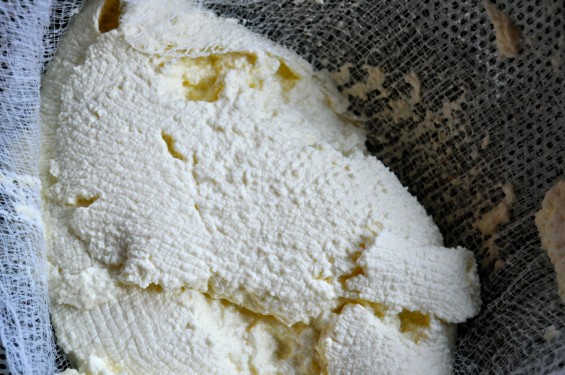
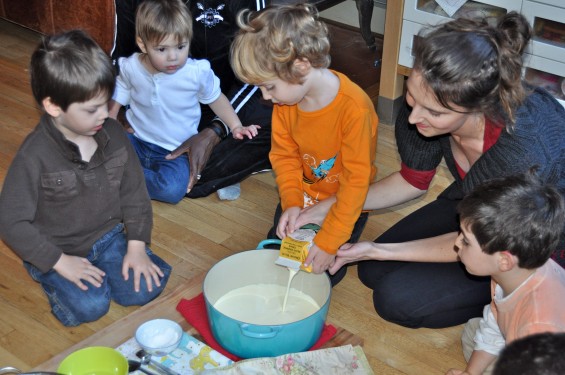
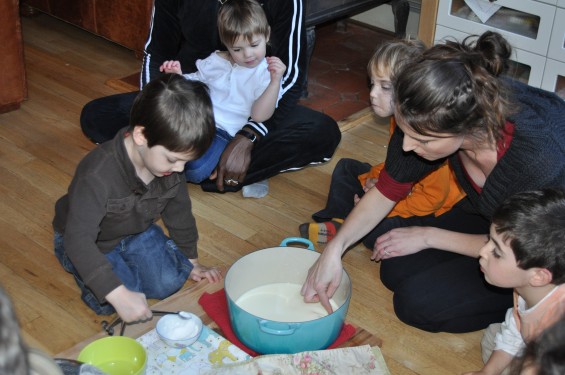
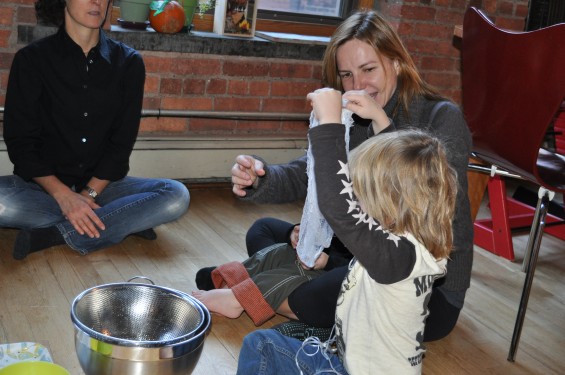
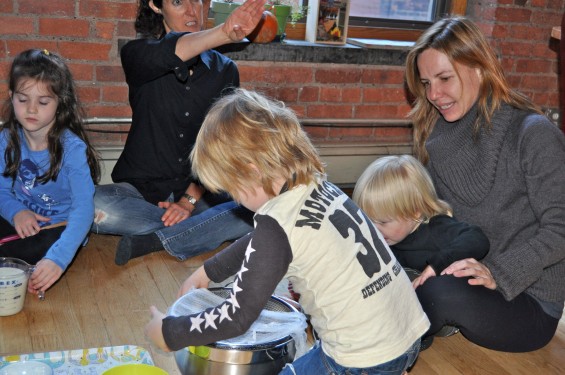
Over the weekend, two of the mamas of mini-chefs in my class sent me an email about ricotta, their love for it, and a recipe they had seen on Gwenyth Paltrow’s blog, GOOP. Gwenyth had been a guest at Ina Garten’s, a.k.a. the Barefoot Contessa, home to sample a couple of the recipes from the BC’s new book, How Easy Is That?: Fabulous Recipes & Easy Tips. Gwenyth shared the recipe for the Contessa’s homemade ricotta that she got to help make and brunch on (lucky girl!).
Gwenyth and Ina totally got my friends’ attention with this one! These two drooling mamas requested that we make both the ricotta and the savory ricotta bruschetta recipe, also provided by Ina Garten, in class this week. While we do not usually bring in celeb chef recipes to class, we had to make an exception for this one. We have been making cheese and yogurt together in our home for a couple of years now, and it seemed time to introduce it to the class.
Ricotta is a wonderful cheese to start with if you are interested in cheese making. There are simple ingredients, minor technique, and big results. I have translated Ina Garten’s recipe, with the exact proportions as the original recipe found here, below so that you can make it easily with your mini-chef. An older child can be at the stove top with you if you are absolutely positive that she/he will be safe. Besides, there is plenty to do apart from your time at the stove and lots to observe and to talk about as the cheese shapes up.
One tip is to use the freshest milk that you can find. We used Ronnybrook milk, which comes from Upstate New York from an organic farm that only minimally processes their milk.
Tomorrow, we will share the recipes for the savory bruschetta as we revised it just a little to suit our tastes and an original recipe for a sweet bruschetta that had the mini-chefs coming back for seconds and thirds.
Ricotta Cheese: Adapted from Ina Garten’s How Easy Is That: Fabulous Recipes and Tips
Yields about 2 c. ricotta
- 4 c. milk, organic and as fresh as possible
- 2 c. heavy cream
- 2 t. salt
- 3 T. good quality white wine vinegar
- a large piece of cheese cloth
- Set a large sieve over a large bowl.
- Into a large, heavy bottomed pot, measure the milk, the cream and the salt and give the mixture a good whisk. As they are whisking, you can discuss how liquidy the mixture is and what that means. (I recommend not measuring out the vinegar yet since it would be very tempting to dump that into the pot, too.)
- Big Person: Place the pot on the stove, uncovered, and bring to a rolling boil over medium heat. Stir it 3-4 times as it heats up.
- Have your mini-chef dip the cheese cloth into a small bowl of water and get the cloth completely wet. Squeeze out most of the water, spread out the cloth, and, folding it in half, place it in the base of the sieve so it covers the entire surface. Set aside.
- Once the milk mixture has come to a rolling boil, turn off the heat, remove it from the stovetop and place it on the floor on top of a cloth or a trivet so that your mini-chef can see what is happening.
- Help your mini-chef measure the vinegar into a small bowl.
- Pour the vinegar into the milk mixture and watch as it begins to separate and turn to cheese before your very eyes. Explain how the milk and cream mixture is curdling and how the liquidy stuff is now moving away from the solid stuff.
- After about a minute of observing and discussing, Big Person will carefully pour the mixture into the cheese cloth-lined sieve.
- Listen. Can you hear all the liquid draining into the bowl beneath, away from the solid parts that will become the cheese?
- Let drain for 35 minutes for soft ricotta or 45 minutes for firmer ricotta (good for stuffing manicotti, ravioli, or using in lasagna), and remove to a bowl.
- Your ricotta can be stored for up to 5 days in a tightly sealed container in the refrigerator.
